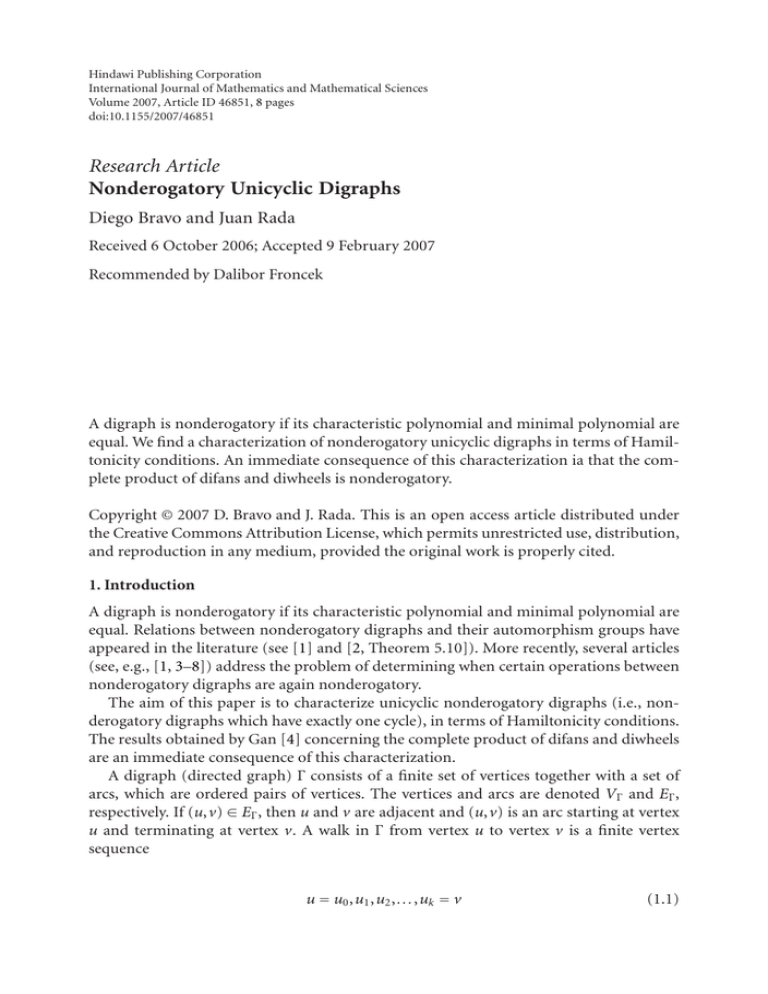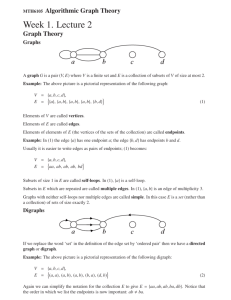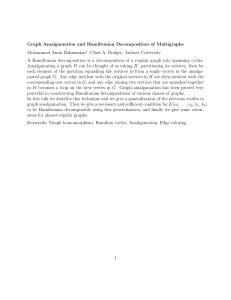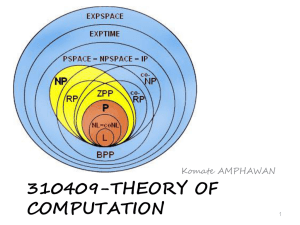Document 10449592
advertisement

Hindawi Publishing Corporation
International Journal of Mathematics and Mathematical Sciences
Volume 2007, Article ID 46851, 8 pages
doi:10.1155/2007/46851
Research Article
Nonderogatory Unicyclic Digraphs
Diego Bravo and Juan Rada
Received 6 October 2006; Accepted 9 February 2007
Recommended by Dalibor Froncek
A digraph is nonderogatory if its characteristic polynomial and minimal polynomial are
equal. We find a characterization of nonderogatory unicyclic digraphs in terms of Hamiltonicity conditions. An immediate consequence of this characterization ia that the complete product of difans and diwheels is nonderogatory.
Copyright © 2007 D. Bravo and J. Rada. This is an open access article distributed under
the Creative Commons Attribution License, which permits unrestricted use, distribution,
and reproduction in any medium, provided the original work is properly cited.
1. Introduction
A digraph is nonderogatory if its characteristic polynomial and minimal polynomial are
equal. Relations between nonderogatory digraphs and their automorphism groups have
appeared in the literature (see [1] and [2, Theorem 5.10]). More recently, several articles
(see, e.g., [1, 3–8]) address the problem of determining when certain operations between
nonderogatory digraphs are again nonderogatory.
The aim of this paper is to characterize unicyclic nonderogatory digraphs (i.e., nonderogatory digraphs which have exactly one cycle), in terms of Hamiltonicity conditions.
The results obtained by Gan [4] concerning the complete product of difans and diwheels
are an immediate consequence of this characterization.
A digraph (directed graph) Γ consists of a finite set of vertices together with a set of
arcs, which are ordered pairs of vertices. The vertices and arcs are denoted VΓ and EΓ ,
respectively. If (u,v) ∈ EΓ , then u and v are adjacent and (u,v) is an arc starting at vertex
u and terminating at vertex v. A walk in Γ from vertex u to vertex v is a finite vertex
sequence
u = u0 ,u1 ,u2 ,...,uk = v
(1.1)
2
International Journal of Mathematics and Mathematical Sciences
(sometimes denoted by u0 → u1 → · · · → uk ), where (ut−1 ,ut ) is an arc of D for all 1 ≤ t ≤
k. The number k is the length of the walk. If u = v, we say that the walk is a closed walk.
A path is a walk in which no vertex is repeated, and a closed path is a cycle.
Suppose that {u1 ,...,un } is the set of vertices of Γ. The adjacency matrix of Γ, denoted
AΓ , is the square matrix of order n whose entry i j is the number of arcs starting at ui and
terminating at u j . The characteristic polynomial of the digraph Γ, denoted by ΦΓ (x) (or
simply ΦΓ ), is the characteristic polynomial of the adjacency matrix AΓ , that is, ΦΓ (x) =
|xI − AΓ |, where I is the identity matrix and |M | is the determinant of M.
By the Cayley-Hamilton theorem, ΦΓ is an annihilating polynomial of AΓ , which
means that ΦΓ (AΓ ) = 0. The monic polynomial of least degree which annihilates AΓ is
called the minimal polynomial of Γ and will be denoted by μΓ (x) (or simply μΓ ). Recall
that if
ΦΓ (x) = x − λ1
q1 q2
qr
· · · x − λr ,
(1.2)
p2
pr
· · · x − λr ,
(1.3)
x − λ2
where q1 ,..., qr are positive integers, then
μΓ (x) = x − λ1
p1 x − λ2
where 1 ≤ pi ≤ qi for all i = 1,...,r.
Definition 1.1. Say that Γ is a nonderogatory digraph if ΦΓ (x) = μΓ (x).
Recall that a linear directed graph L is a digraph in which every vertex has indegree and
outdegree equal to 1; in other words, its components are cycles. The coefficient theorem
for digraphs relates the coefficients of the characteristic polynomial of a digraph Γ with
the set of linear directed subgraphs of Γ.
Theorem 1.2 (see [2, Theorem 1.2]). Let Γ be a digraph with n vertices. Then the characteristic polynomial ΦΓ of Γ is
ΦΓ = xn + c1 xn−1 + c2 xn−2 + · · · + cn ,
(1.4)
where ci = L∈ᏸi (−1) p(L) . Here, ᏸi is the set of linear directed subgraphs L of Γ with exactly
i vertices, and p(L) is the number of components of L.
A spanning path in a digraph Γ is called a Hamiltonian path. A path-Hamiltonian
digraph is a digraph which contains a Hamiltonian path. Then we have a characterization
of acyclic nonderogatory digraphs.
Proposition 1.3. Let Γ be a digraph with n vertices. The following are equivalent:
(i) Γ is an acyclic nonderogatory digraph;
(ii) Γ is path-Hamiltonian.
Proof. Recall that the entry uv of the power matrix An−1 is precisely the number of walks
in Γ of length n − 1 from u to v (see [2, Theorem 1.9]). By Theorem 1.2, if Γ is an acyclic
digraph with n vertices, then its characteristic polynomial is simply ΦΓ = xn . Hence, Γ is
nonderogatory if and only if An−1 = 0. If Γ is acyclic, any walk is necessarily a path, and a
path of length n − 1 is necessarily spanning and hence Hamiltonian. From this, it follows
D. Bravo and J. Rada 3
that Γ is a nonderogatory acyclic digraph if and only if there exists a walk of length n − 1
if and only if Γ is path-Hamiltonian.
2. Nonderogatory unicyclic digraphs
Let Γ p (u,v) denote the set of walks in Γ of length p from vertex u to vertex v. By [2,
Theorem 1.9], the entry uv of A p is the number of walks from u to v of length p.
Proposition 2.1. Let Γ be a digraph with n vertices and unique cycle C of length r ≥ 2. The
following conditions are equivalent:
(1) Γ is a nonderogatory digraph;
(2) there exists u,v ∈ VΓ such that |Γn−1 (u,v)| = |Γn−r −1 (u,v)|.
Proof. From Theorem 1.2, the characteristic polynomial of Γ is
Φ Γ = x n − x n −r = x n −r x r − 1 .
(2.1)
Since xr − 1 is a product of distinct linear factors, the minimal polynomial μΓ has the
form
μΓ = x p x r − 1 ,
(2.2)
where 1 ≤ p ≤ n − r. Hence, Γ is a nonderogatory digraph if and only if
An−r −1 Ar − I = 0
(2.3)
An−1 = An−r −1 .
(2.4)
or equivalently,
In the next results, we give further insight into condition 2 of Proposition 2.1.
Assume that {x1 ,...,xr } are the vertices of C, and (xi ,xi+1 ), for i = 1,...,r − 1, together with (xr ,x1 ) are the arcs of C. For each 1 ≤ j ≤ r, let C(x j ) denote the closed walk
x j ,...,xr ,x1 ,...,x j . For u,v ∈ VΓ , define
Γ◦p (u,v) = π ∈ Γ p (u,v) : π contains C x j for some x j (1 ≤ j ≤ r) ,
Γ∗p (u,v) = π ∈ Γ p (u,v) : π contains x j for some x j (1 ≤ j ≤ r) .
(2.5)
Lemma 2.2. Let Γ be a digraph with n vertices and unique cycle C of length r ≥ 2. Then
|Γ◦n−1 (u,v)| = |Γ∗
n−r −1 (u,v)| for every u,v ∈ VΓ .
Proof. Note that, π = u · · · x j · · · v ∈ Γ∗n−r −1 (u,v) if and only if π = u · · · C(x j ) · · · v ∈
Γ◦n−1 (u,v). Consequently, the function Ψ : Γ∗n−r −1 (u,v) → Γ◦n−1 (u,v) defined as Ψ(π) = π
is bijective and the result follows.
Note that, in particular, Γ∗n−r −1 (u,v) = ∅ if and only if Γ◦n−1 (u,v) = ∅ and in this case,
◦
Γ
n−1 (u,v)
∗
= Γ
n−r −1 (u,v)
= 0.
(2.6)
4
International Journal of Mathematics and Mathematical Sciences
Let Γ − C be the digraph obtained from Γ by deleting the vertices of C and the arcs
incident to them.
Lemma 2.3. Let Γ be a digraph with n vertices and unique cycle C of length r ≥ 2. Then
(1) Γn−1 (u,v)\Γ◦n−1 (u,v) is the (possibly empty) set of Hamiltonian paths of Γ from u
to v;
(2) Γn−r −1 (u,v)\Γ∗n−r −1 (u,v) is the (possibly empty) set of Hamiltonian paths of Γ − C
from u to v.
Proof. (1) Clearly, a Hamiltonian path of Γ from u to v is a path of length n − 1 which
does not contain C. Conversely, assume that π ∈ Γn−1 (u,v)\Γ◦n−1 (u,v). Then π is a walk
of length n − 1 from u to v that does not contain the cycle C. Since C is the unique cycle
of Γ, then clearly π is a spanning path of Γ from u to v.
(2) First, note that Γ − C is a digraph with n − r vertices. It is clear that every Hamiltonian path in Γ − C belongs to Γn−r −1 (u,v)\Γ∗n−r −1 (u,v). Conversely, if σ ∈ Γn−r −1 (u,v)\
Γ∗n−r −1 (u,v), then σ is a walk in Γ − C of length n − r − 1. Since Γ − C is acyclic, it follows
that σ is a Hamiltonian path in Γ − C.
For every u,v ∈ VΓ , we define
h◦ (u,v) = Γn−1 (u,v)\Γ◦n−1 (u,v),
h∗ (u,v) = Γn−r −1 (u,v)\Γ∗n−r −1 (u,v).
(2.7)
By Lemma 2.3, h◦ (u,v) (resp., h∗ (u,v)) is the number of Hamiltonian paths in Γ (resp.,
Γ − C) from vertex u to vertex v.
If Γ − C is path-Hamiltonian, then its structure is very simple, as we can see in the next
result.
Proposition 2.4. Let Ω be an acyclic path-Hamiltonian digraph with n vertices. Then Ω is
obtained from Pn = u1 → u2 → · · · → un by adding some edges of the form u j → uk , where
k > j.
Proof. Let π : u1 → u2 → · · · → un be a spanning path of Ω and assume that u j → uk
belongs to Ω, where k < j. Then
uk −→ · · · −→ u j −→ uk
is a cycle in Ω, which is a contradiction.
(2.8)
In particular, an acyclic path-Hamiltonian digraph Ω has a unique Hamiltonian path:
it starts in the unique vertex of indegree 0 and it ends in the unique vertex of outdegree 0
of Ω.
Now, we can characterize nonderogatory unicyclic digraphs in terms of Hamiltonicity
conditions. We distinguish the following two cases:
(a) Γ − C is path-Hamiltonian, and so Γ − C has the form given in Proposition 2.4;
(b) Γ − C is not path-Hamiltonian.
D. Bravo and J. Rada 5
Theorem 2.5. Let Γ be a digraph with n vertices and unique cycle C of length r ≥ 2.
(1) If Γ − C is not path-Hamiltonian, then
Γ is nonderogatory ⇐⇒ Γ is path-Hamiltonian.
(2.9)
(2) If Γ − C is path-Hamiltonian with unique Hamiltonian path from u to v, then
Γ is nonderogatory ⇐⇒ h◦ (u,v) = 1.
(2.10)
Proof. By Proposition 2.1, Γ is nonderogatory if and only if there exists u,v ∈ VΓ such
that |Γn−1 (u,v)| = |Γn−r −1 (u,v)|. Note that Γn−1 (u,v) and Γn−r −1 (u,v) can be expressed
as disjoint unions
Γn−1 (u,v) = Γ◦n−1 (u,v) ∪ Γn−1 (u,v)\Γ◦n−1 (u,v) ,
Γn−r −1 (u,v) = Γ∗n−r −1 (u,v) ∪ Γn−r −1 (u,v)\Γ∗n−1 (u,v) .
(2.11)
It follows from Lemma 2.2 that
Γ is nonderogatory ⇐⇒ h◦ (u,v) = h∗ (u,v)
for some u,v ∈ VΓ .
(2.12)
(1) Assume that Γ − C is not path-Hamiltonian. Then h∗ (u,v) = 0 for every u,v ∈ VΓ . It
follows from (2.12) and Lemma 2.3 that
Γ is nonderogatory ⇐⇒ h◦ (u,v) = 0 for some u,v ∈ VΓ
⇐⇒ Γ is path-Hamiltonian.
(2.13)
(2) Assume that Γ − C is path-Hamiltonian with unique Hamiltonian path from vertex
u to vertex v. Then h∗ (u,v) = 1 and h∗ (w,z) = 0 for every other pair of vertices w and
z in VΓ . It follows from (2.12) that if h◦ (u,v) = 1, then Γ is nonderogatory. Now, assume
that h◦ (u,v) = 1. We will show that h◦ (w,z) = 0 for every other pair of vertices w and z in
VΓ , which implies that Γ is derogatory. Let π be a Hamiltonian path in Γ from u to v and
suppose that there is a Hamiltonian path σ in Γ from w to z. If w = u, then there exists an
arc w → u in Γ. Since π induces a path from u to w , then a cycle in Γ is formed different
from C. This is a contradiction, so w must equal u. Similarly, z = v.
Example 2.6. In this example we turn our attention to a well-known operation between
digraphs, the so-called coalescence of digraphs, considered in [8].
Let Fr · Wq be the coalescence of Fr and Wq with respect to the hub of both digraphs
(see Figure 2.1).
Fr · Wq is unicyclic with unique cycle C = tr+1 ,tr+2 ,...,tr+q−2 ,tr+q−1 ,tr+1 . Note that Fr ·
Wq − C = Fr which is path-Hamiltonian with unique Hamiltonian path tr → t1 → · · · →
tr −1 . Moreover, h◦ (tr ,tr −1 ) = 0. Hence, by Theorem 2.5, Fr · Wq is nonderogatory.
Example 2.7. Consider the digraph D shown in Figure 2.2.
D is unicyclic with unique cycle C = u5 ,u2 ,u3 ,u4 ,u5 of length 4. Observe that neither
D − C nor D is path-Hamiltonian. Consecuently, by Theorem 2.5, D is derogatory.
6
International Journal of Mathematics and Mathematical Sciences
ur
ur
1
ur
2
ur
3
tr
vq
tr+q
1
v1
u3
vq
vq
tr+2
tr+3
v3
u1
Diwheel Wq
Difan Fr
(a)
tr+q
tr
2
v2
u2
1
tr+1
Coalescence Fr Wq
(b)
2
1
tr
2
tr
3
t3
t2
t1
(c)
Figure 2.1
u1
u6
u7
u5
u4
u2
u3
D
Figure 2.2
The results of Gan [4] follow immediately from Theorem 2.5, as we can see in the next
example. But first recall that the complete product D1 ⊗ D2 of digraphs D1 and D2 is the
digraph obtained by joining every vertex of D1 to every vertex of D2 with an arc directed
from the vertex of D1 to the vertex of D2 .
Example 2.8. (1) Consider the complete product Fq ⊗ Wr (see Figure 2.3).
Note that Fq ⊗ Wr is unicyclic with unique cycle C = v1 ,v2 ,...,vr −1 ,v1 ; (Fq ⊗
Wr ) − C is path-Hamiltonian with unique Hamiltonian path vr+q → vr+1 → vr+2 →
· · · → vr+q−1 → vr and h◦ (vr+q ,vr ) = 0. Thus, by Theorem 2.5, Fq ⊗ Wr is nonderogatory.
(2) Consider the complete product Wq ⊗ Fr (see Figure 2.4).
Note that Wq ⊗ Fr is unicyclic with unique cycle C = vr+1 ,vr+2 ,...,vr+q−1 ,vr+1 ;
(Wq ⊗ Fr ) − C is path-Hamiltonian with unique Hamiltonian path vr+q → vr →
v1 → · · · → vr −2 → vr −1 and h◦ (vr+q ,vr −1 ) > 1. Thus, by Theorem 2.5, Wq ⊗ Fr is
nonderogatory.
D. Bravo and J. Rada 7
vr+q
vr+q
1
vr+q
2
vr+q
3
vr
1
v1
vr
vr+3
vr
2
v2
vr+2
v3
vr+1
Fq ª Wr
Figure 2.3
vr+q
1
vr+1
vr+q
vr+q
vr
2
vr+2
vr+3
vr
1
vr
2
vr
3
v3
v2
Wq ª Fr
v1
Figure 2.4
Acknowledgment
Financial support was received from Consejo de Desarrollo Cientı́fico, Humanı́stico y
Tecnológico de la Universidad de Los Andes (CDCHT, C-13490505B).
References
[1] A. Mowshowitz, “Graphs, groups and matrices,” in Proceedings of the 25th Summer Meeting of the
Canadian Mathematical Congress, pp. 509–522, Lakehead University, Thunder Bay, Ont, Canada,
1971.
[2] D. M. Cvetković, M. Doob, and H. Sachs, Spectra of Graphs, vol. 87 of Pure and Applied Mathematics, Academic Press, New York, NY, USA, 1980.
[3] C. S. Gan and V. C. Koo, “On annihilating uniqueness of directed windmills,” in Proceedings of
the 7th Asian Technology Conference in Mathematics (ATCM ’02), Melaka, Malaysia, December
2002.
[4] C. S. Gan, “The complete product of annihilatingly unique digraphs,” International Journal of
Mathematics and Mathematical Sciences, vol. 2005, no. 9, pp. 1327–1331, 2005.
[5] K. S. Lam, On digraphs with unique annihilating polynomial, Ph.D. thesis, University of Malaya,
Kuala Lumpur, Malaysia, 1990.
[6] C.-K. Lim and K. S. Lam, “The characteristic polynomial of ladder digraph and an annihilating
uniqueness theorem,” Discrete Mathematics, vol. 151, no. 1–3, pp. 161–167, 1996.
8
International Journal of Mathematics and Mathematical Sciences
[7] J. Rada, “Non-derogatory directed windmills,” in preparation.
[8] D. Bravo and J. Rada, “Coalescence of difans and diwheels,” to appear in Bulletin of the Malaysian
Mathematical Sciences Society.
Diego Bravo: Departamento de Matemáticas, Facultad de Ciencias, Universidad de Los Andes,
Mérida 5101, Venezuela
Email address: dbravo@ula.ve
Juan Rada: Departamento de Matemáticas, Facultad de Ciencias, Universidad de Los Andes,
Mérida 5101, Venezuela
Email address: juanrada@ula.ve








